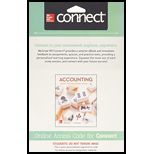
Conceptual Introduction:
Stockholders' equity
Net income or loss of Hughey Inc.
Answer to Problem 8.5E
Net income for the year of Hughey Inc. is $1, 27,000
Explanation of Solution
Firstly, the beginning paid-in capital is calculated using the following formula:
In the given problem, it is given that ending paid-in capital is $90,000 and there has been increase of $20,000 in the year.
Thereafter Beginning
Beginning owner's equity is given as $2, 60,000 and beginning paid-in capital has been calculated as $70,000.
Now, liabilities at the beginning of the year need to be calculated with the help of following formula:
Liabilities at the end of the year are given as $1, 16,000 and an increase of $11,000 has been taken place in the year.
Thereafter, assets as on the beginning of the year will be calculated using the following:
Beginning liabilities have been worked out as $1, 05,000 and beginning owners equity is given as $2, 60,000.
Now, assets at the end of the year would be calculated using the following formula:
Beginning assets have been calculated as $3, 65,000 and there has been an increase of $1, 30,000 in the assets.
Ending retained earnings needs to be calculated with the help of following formula:
Ending assets have been calculated as $4, 95,000, ending liabilities are given as $1, 16,000 and ending paid-in capital is $90,000.
Finally, retained earnings at the end of the year would be calculated as follows:
Beginning retained earnings has been calculated as $2, 89,000, dividend is $28,000 and beginning retained earnings is $1, 90,000.
All the above calculations can be seen from the table below:
| Particulars | A | = | L | + | OE | ||
| PIC | + | RE | |||||
| Beginning | 3,65,000 | = | 1,05,000 | + | 70,000 | + | 2,60,000 |
| Add: Changes | 1,30,000 | = | 11,000 | + | 20,000 | + | 2,89,000 (28,000) |
| Ending | 4,95,000 | = | 1,16,000 | + | 90,000 | + | 2,89,000 |
Thus, the net income amount comes out to $1, 27,000.
Want to see more full solutions like this?
Chapter 8 Solutions
Connect Access Card for Accounting: What the Numbers Mean

 AccountingAccountingISBN:9781337272094Author:WARREN, Carl S., Reeve, James M., Duchac, Jonathan E.Publisher:Cengage Learning,
AccountingAccountingISBN:9781337272094Author:WARREN, Carl S., Reeve, James M., Duchac, Jonathan E.Publisher:Cengage Learning, Accounting Information SystemsAccountingISBN:9781337619202Author:Hall, James A.Publisher:Cengage Learning,
Accounting Information SystemsAccountingISBN:9781337619202Author:Hall, James A.Publisher:Cengage Learning, Horngren's Cost Accounting: A Managerial Emphasis...AccountingISBN:9780134475585Author:Srikant M. Datar, Madhav V. RajanPublisher:PEARSON
Horngren's Cost Accounting: A Managerial Emphasis...AccountingISBN:9780134475585Author:Srikant M. Datar, Madhav V. RajanPublisher:PEARSON Intermediate AccountingAccountingISBN:9781259722660Author:J. David Spiceland, Mark W. Nelson, Wayne M ThomasPublisher:McGraw-Hill Education
Intermediate AccountingAccountingISBN:9781259722660Author:J. David Spiceland, Mark W. Nelson, Wayne M ThomasPublisher:McGraw-Hill Education Financial and Managerial AccountingAccountingISBN:9781259726705Author:John J Wild, Ken W. Shaw, Barbara Chiappetta Fundamental Accounting PrinciplesPublisher:McGraw-Hill Education
Financial and Managerial AccountingAccountingISBN:9781259726705Author:John J Wild, Ken W. Shaw, Barbara Chiappetta Fundamental Accounting PrinciplesPublisher:McGraw-Hill Education





